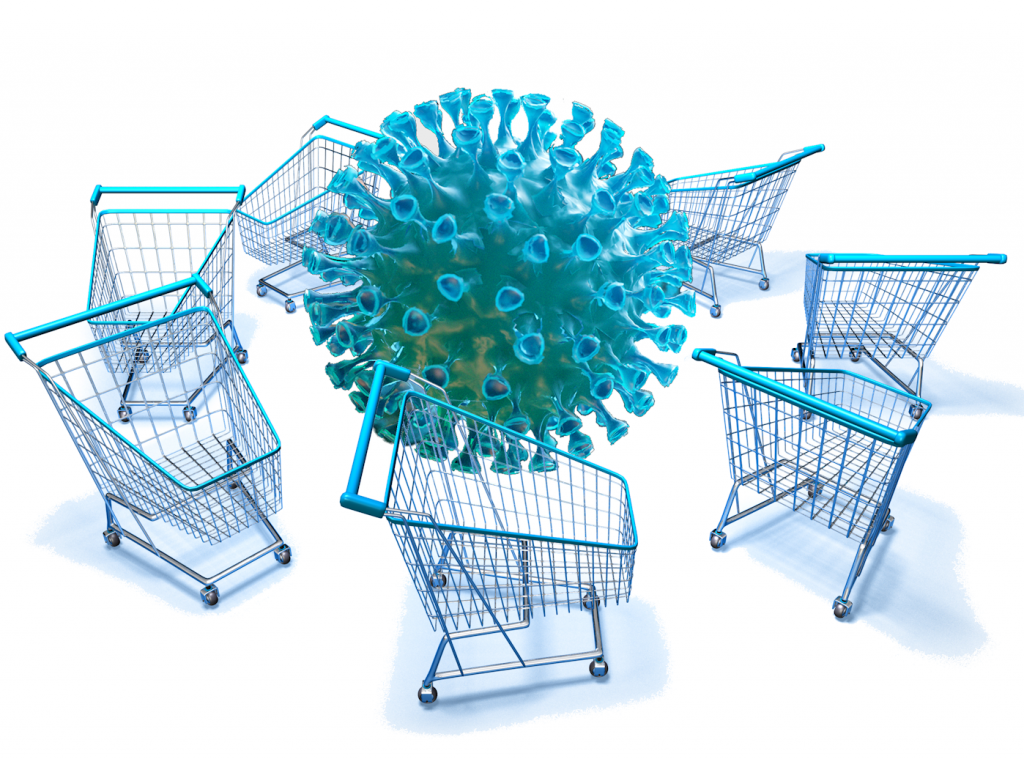“Traditional shopping habits are being fractured nationwide as U.S. consumers grapple with uncertainty about the impact of novel coronavirus (COVID-19),” writes Russell Redman. “In grocery, many consumers are shopping differently.”[1] This three-part article examines just how differently consumer behavior is changing the food sector. In part one , I examined five of fourteen food sector areas being affected by the Covid-19 pandemic as identified from numerous sources by Jim Dippold, Senior Vice President for Category Management Strategy at Enterra Solutions®. Those areas were: Shopping Behavior Habits; Consumer Eating Habits; Retail In-store Operations; Retail Headquarter Operations; and Retailer Price and Promotion. In this article, I’ll look at four more of Jim’s areas: Retail Product Mix; Media; Supply; and Corporate Image. In the concluding part of the article, I’ll look at Jim’s final four areas, which look deeper into the future: Business Forecast; Technology; Recession; and Society and Community.
Retail Product Mix
Facts: During the period of isolation, consumers buy available products — not necessarily brands to which they have been loyal. As a result, consumers are trying new products and may develop new brand loyalties. Brands claiming they can help boost people’s immune systems have reportedly been out of stock and are posting skyrocketing sales. When such claim prove specious, those brands may suffer irreparable harm. Hunkering down for an unknown period of isolation has created a spike in overall category purchases. An influx of items from nontraditional suppliers have taken over empty spaces on shelves. There has been a reduction of assortment range in many categories. Both individual and business consumers have generated a leap in sales of janitorial supplies, like disinfectant wipes and cleansers, driving double-digit dollar gains. Work-from-home supplies will be the next strong category to benefit from an extended period of isolation.
Inferences: Cheaper products, as well as abundant products with lower historical penetration, will see expanded sales as a result of stockpiling. There is potential for long-term growth in lesser known brands as current demand surpasses demand from their current niche set of consumers. The direct opposite effect could be seen by market leaders as they lose market share to lesser known brands. The pandemic will help bolster the health and wellness industry, spur new innovation across the sector, and result in demand for items like masks and thermometers beyond the end of the crisis. Some brands will gain a lot of new customers as brands not normally stocked in local grocers appear on store shelves as replacement items. New products, not previously distributed in grocery channels may gain shelf space. This is an advantage for big brands with greater capacity than smaller brands, whose long-tail supply chain may be unable to cope with current demand. For retailers, it’s okay to stock items that serve the purpose but aren’t normal substitutions for the customer.
Media
Facts: Brands maintaining a minimum to moderate level of media continuity during recessionary times tend to gain share of voice and market share. They also recover faster as well and outperform competition over the following one to two years. The current situation amplifies consumers reliance on media, and radio stations and advertisers have an opportunity to create lasting relationships with an extremely captive audience. In the ‘New Normal’ of COVID-19, local TV news proves to be the medium of choice for news and information. Radio is ‘Comfort Food’ as media consumption rises amid the Covid-19 pandemic. There has been a significant shift from mobile viewership to TV and desktop viewership as consumers stay in and work from home. Email advertising is gaining better penetration as consumers with time on their hands open emails they normally could care less about.
Advertisers are challenged to balance the need for cost management with the desire to pursue new opportunities during periods of disruption and uncertainty. Open rates on emails from grocers have jumped by 10 points or more during the crisis. Advertisers are leveraging holistic and unified marketing platforms to target customer segments in real-time. They are also redeploying investments out of under performing vehicles and into over performing vehicles. Marketers are having to prioritize budget reduction needs across product portfolios while limiting the revenue/profit downside. Budget flexibility, as well as creative flexibility, delivers both short-term revenue impact and cost savings. This period of isolation provides an opportunity to rapidly deploy and test a variety of offers and be creative in different markets/geographies to see what works. There is an opportunity to maintain/grow sales in the most responsive markets with customers who react favorably to offers. There is a need to modify creative to focus on products most relevant to future trip types and tailor promo/media plans to focus on channels most effective at driving those trip types.
Inferences: By balancing media optimization objectives to drive e-commerce, online ordering, and owned channel growth, marketers are able to quickly, and in an agile manner, shift consumer demand and conversion across these channels. There’s an email marketing opportunity for retailers because people, even the 25% or 35% of them who never open emails, are opening them as they work from home. Marketers need to ensure messages are appropriate for the time. They need to be flexible and adaptable as conditions change and identify the most effective digital campaigns across paid and owned channels. As always, they need to assess minimum cost/maximum impact media vehicles and campaigns and balance national vs. spot and brand- vs. media-based campaigns as dictated by local market conditions.
Supply
Facts: Supply chains are shuffling between urgent replenishment and halted needs. Retailers are forming employment partnerships with local, regional and national businesses in other industries to ensure an undisrupted food supply chain and help displaced workers. Some organizations are developing a shared-resource model with companies in hard-hit sectors — such as restaurants, hotels and food service distributors in order to temporarily flex employees into retailer roles.
Inferences: There is increased pressure on corporations to weigh the efficiency and costs/benefits of a globalized supply chain system against the robustness of a domestic-based supply chain. The pandemic has demonstrated an unhealthy reliance on China and may result in stronger domestic supply chains. Retailers collaborating with other industries to bolster employment may develop new relationships. Switching to a more robust domestic supply chain would reduce dependence on an increasingly fractured global supply system; however, while this would better ensure that people get the goods they need, this shift would likely also increase costs to corporations and consumers. Interrupted retail supply chains are directing consumers to manufacturers and increasing direct-to-consumer (DTC) businesses. As a result, DTC businesses will evolve at a rapid pace. The combination of domestic supply and DTC will give rise to local players who have identified niche segments or consumer needs, and recognize the advantages of direct consumer reach, powered by technology. With retail supply chains progressively challenged due to COVID-19, many consumers, faced with empty shelves, will look for alternative online sources to find the products they need. With temporary uncertainty around packaging supplies, some manufacturers will work to secure three to four months of material supply from various U.S.-based warehouses and eliminate risks to any international sources.
Corporate Image
Facts: Historically, consumers reward brands that do the right thing during a crisis (i.e., they are there to serve, not to sell). Companies trying to take advantage of the crisis will suffer difficult-to-repair damage to their reputation. Companies providing false or misleading information to sell their products will also suffer damage to their reputation.
Inferences: Organizations telling the truth, valuing people over profits, and using resources for the greater good, will glean good press and increased customer loyalty. Pundits believe what happens to brands AFTER this pandemic will be heavily influenced by what they did DURING it. Since consumers tend to reward good corporate stewardship, companies doing the right thing should see an uptick in sales and customer loyalty once the pandemic/recession has passed.
As noted at the beginning of this article, I’ll look at Jim’s final four areas in the conclusion of this article. Those areas take a look deeper into the future and cover the following topics: Business Forecast; Technology; Recession; and Society and Community.
Footnotes
[1] Russell Redman, “How the coronavirus crisis is changing grocery shopping,” Supermarket News, 3 April 2020.





